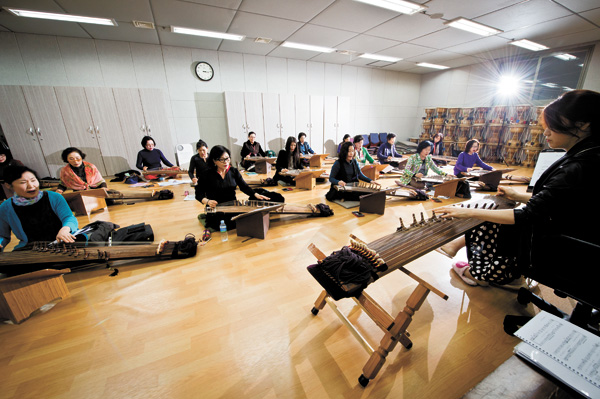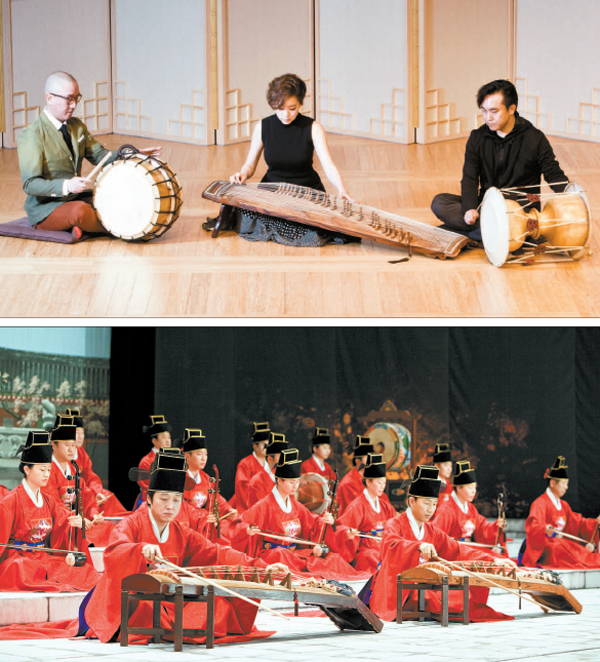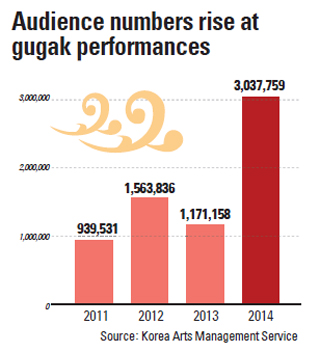Traditional music experiences a renaissance

Students at the intensive course on gayageum, Korea’s zither-like traditional instrument, concentrate on its tones. The number of people attending gugak (traditional Korean music) performances has increased, and so has the number of people learning traditional instruments and dances. By Kim Gyeong-rok
Young Koreans nowadays are rarely given the opportunity to experience gugak during school or even after they graduate.
As a result, they are more familiar with the melodies and beats of Western music than those of traditional flutes, fiddles or drums.
But there are signs that this is changing. The number of people who watched a gugak performance in Korea last year broke the three million mark for the first time, according to industry figures. This is actually three times the number recorded in 2011.
And there are more people learning gugak as well. Cultural institutions across the country have added more gugak classes. Most are reportedly fully booked, and for some popular courses applicants must wait almost a year to get in.
Experts note how the younger generation’s interest in gugak is also higher than ever, thanks mainly to young gugak stars making appearances on entertainment shows.
Young gugak artists working with other musicians, giving a modern twist to the traditional tunes and holding “fusion” performances are other factors contributing to the traditional genre’s newfound popularity in today’s society.
Rediscovering native music
During the haegeum class on March 30 at the National Gugak Center in Seocho-dong, southern Seoul, tones that were somehow both sharp and soft filled the room.

Top: Drummer Nam Gung-yeon, gayageum player Ju Bo-ra and percussionist Min Young-chi (from left to right) give an impromptu gugak, or traditional Korean music, performance. Above: Sujecheon is a gugak performance that is recommended for those who want to listen to completely traditional gugak. [JoongAng Ilbo]
The 10 students in the advanced class were deep in concentration with the instrument on their knees, their right hands moving the bow and the fingers of their left hands navigating the instrument’s two strings.
“I feel something from the haegeum that I didn’t feel from learning Western music and playing the piano,” said Min Geum-ok, one of the students at the class.
Min, who’s been learning haegeum for five years now, took piano in college.
“The haegeum is not tuned within a certain framework,” the 62-year-old said. “I think that’s why people can hear the player’s inner sounds from the haegeum.”
Another student, Yoo Jin-hee, agrees.
“In Western music, people try to be accurate with their notes and follow exactly what’s on the score,” she said. “But with the haegeum, the notes people make differ slightly and that’s okay as it is. In fact, that’s the biggest charm of haegeum: That people can exude their own color.”
Ten years ago, the National Gugak Center only had two classes on the instrument. Today the number has increased to 10.
“It seems more people feel closer to haegeum these days, as haegeum songs are often featured on the soundtracks of popular films and dramas,” said Kwon Mi-so, a professor of traditional music who teaches the advanced class.
It was a similar story in the gayageum class going on next door.
“There used be just one class on gayageum, but with people’s increased demands, there are now four,” said Mun Su-jeong, a professor who has taught the zither-like string instrument at the National Gugak Center for 13 years. “People today want to be able to play the instruments themselves.”
Students in Mun’s class shared the awe they feel about the 12-string instrument.

“There are charms in traditional Korean music that cannot be found in music elsewhere,” said another student, Hwang Geum-ja. “The more you learn, the more you get into it.”
Former actor and Culture Minister Yu In-chon is also reportedly studying the gayageum. He said he has always believed that learning Korean traditions is a must for a Korean actor, adding that the world of the gayageum is so profound that he plans to study the instrument for the next 10 years.
The cool side of gugak
Currently, there are about 90 classes on gugak, as well as traditional dance, run by the Korean Traditional Performing Arts Foundation, which operates under the Culture Ministry with the aim of advancing the traditional performance art scene. The courses have about 1,000 students.
“Although most of the students are women in their 50s and 60s, we are also seeing an increase in the number of middle-aged men applying for the classes,” said Yun Ji, an official at the foundation.

Young gugak stars who make frequent appearances on TV are adding to the popularity of the traditional music genre. From left: Gugak performer Park Aeri and her B-boy dancer husband, Poppin Hyun Joon; Geomungo-Factory; Song So-hee; and Luna Lee. [JoongAng Ilbo]
Gugak lessons at regional cultural institutions across the country are also rising. Kim Yeol-su of the Gyeonggi Arts Center, who oversees traditional performance arts at the venue, said it receives about 700 people every three months for its gugak and traditional performing arts classes.
“Most of the classes are fully-booked,” he said. “But some classes, like those on sogo [small drum] dance and salpuri dance, are so popular that people have to wait a year to get in.”
Korean drummer Nam Gung-yeon is also into gugak these days.
Having teamed up with Korean-Japanese percussionist Min Young-chi, Nam has formed the gugak group K-Beat Ensemble in the hopes that people will learn that the traditional form of music can be “cool” and contemporary.
The group and gayageum player Ju Bo-ra gave an impromptu performance at the National Gugak Center on March 30. Min began playing the janggo, or the traditional drum; Ju came in next with her gayageum; and, finally, Nam joined in with another drum.
“The best thing about gugak is that even if a new player joins in, it just flows naturally,” Min said.
Nam agreed. “There is nothing set in gugak. It’s raw. It is as it is.”
Gugak is looking - or sounding - more “trendy” because of young gugak stars such as Song So-hee. The 18-year-old recently emerged as a new girl-next-door figure when she appeared on a TV commercial for the telecom company KT. Song has the looks of the famous pop group Girls’ Generation, except she sings in the traditional style.
Luna Lee is another young gugak artist who has catapulted to stardom. Her gayageum performance on YouTube of Jimi Hendrix’s “Voodoo Chile” has achieved more than 3 million views and she will tour Europe next month and the United States later this year.
Gugak performer Park Aeri and her B-boy dancer husband Poppin Hyun Joon also make regular appearances on a TV variety show, where they are asked to choreograph a performance together on the spot.
New experiments
Baraji, a group of gugak artists in their 20s and 30s, are attempting to breathe new life into the genre.
One of the act’s members, Won Na-kyung, said people tend to think gugak is hard to grasp because its lyrics are usually in an older style, often based on Chinese characters.
“We compose songs in today’s languages and play them in gugak in the hopes of getting closer to the people today.”
Jambinai is another young gugak group trying to bring the style to the general public. The act plays contemporary songs with traditional instruments and has given more than 30 performance in Europe, the United States and elsewhere. Lee Il-u, a member of the group, says audiences in Europe especially responded enthusiastically to the rock music they played.
Geomungo-Factory also brought a new meaning to geomungo, the traditional zither. The band created a new one-meter (3.3 feet) version of the traditional instrument, which usually measures 1.6 meters. The geomungo is usually placed on the ground when it is played, but the members of Geomungo-Factory use it like guitar, or cello. They also introduced an electronic geomungo.
With those updated instruments, the group also plays tango and flamenco music.
“We wanted to share the joy and fun of gugak with the younger generation who have enjoyed a wide spectrum of musical genres,” said Lee Jeong-seok, a member of the group.
Experts say gugak has abundant potential.
“If Western music is a box, gugak is a sack,” said Jeon In-pyeong, an emeritus professor of traditional arts at Chung-Ang University. “With a box, people should think of its size and function before filling it in with stuff. But a sack accommodates - it can embrace things that are big, things that are small.”
Yim Jun-hee, a professor at Korea National University of Arts’ department of composition, said, “As Korea experiences rapid modernization and economic growth, people had this notion that Western music is better than gugak,” she said. “But since the 2000s, as gugak artists became active with creative work and performances, they showed gugak can change and break the mold. Such efforts are bearing fruit.”
Han Seung-seok, a performing arts professor at Chung-Ang University, said that it’s natural for different art genres to blend and create something new as time progresses. He added, however, that “an in-depth study and learning of traditional gugak and its culture should also take place at the same time.”
BY CHO HAN-DAE, KIM HYUNG-EUN [hkim@joongang.co.kr]










with the Korea JoongAng Daily
To write comments, please log in to one of the accounts.
Standards Board Policy (0/250자)